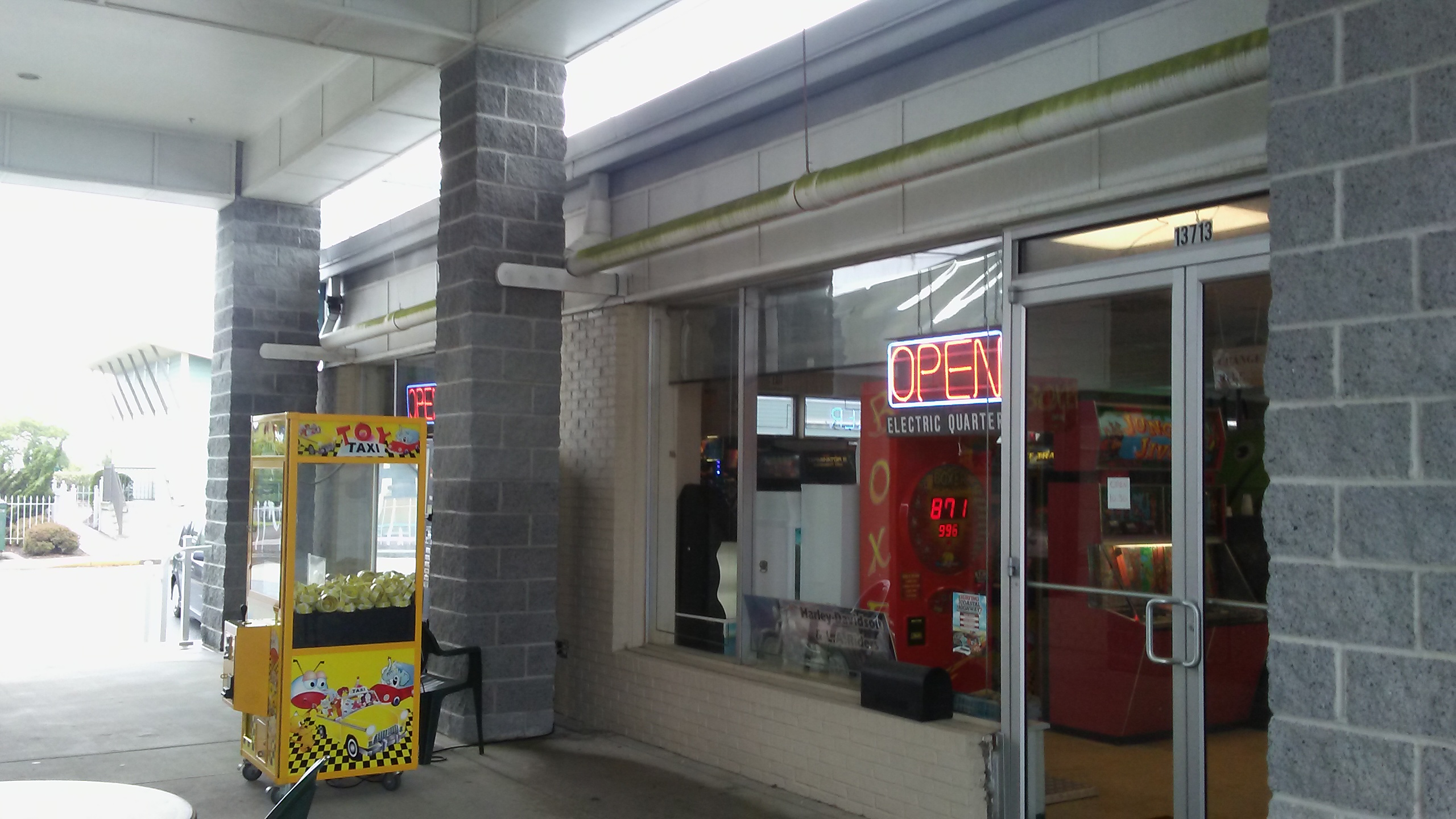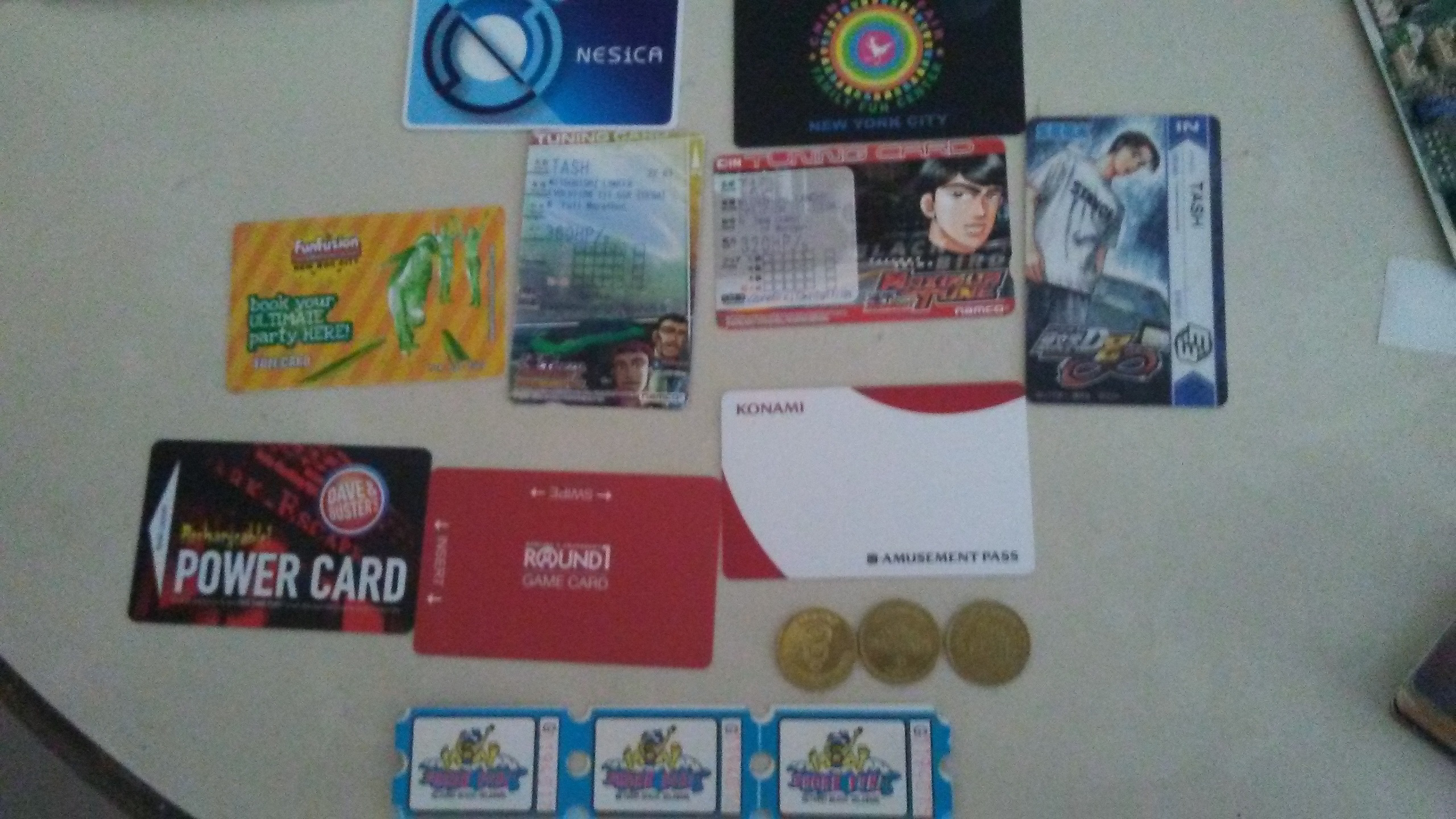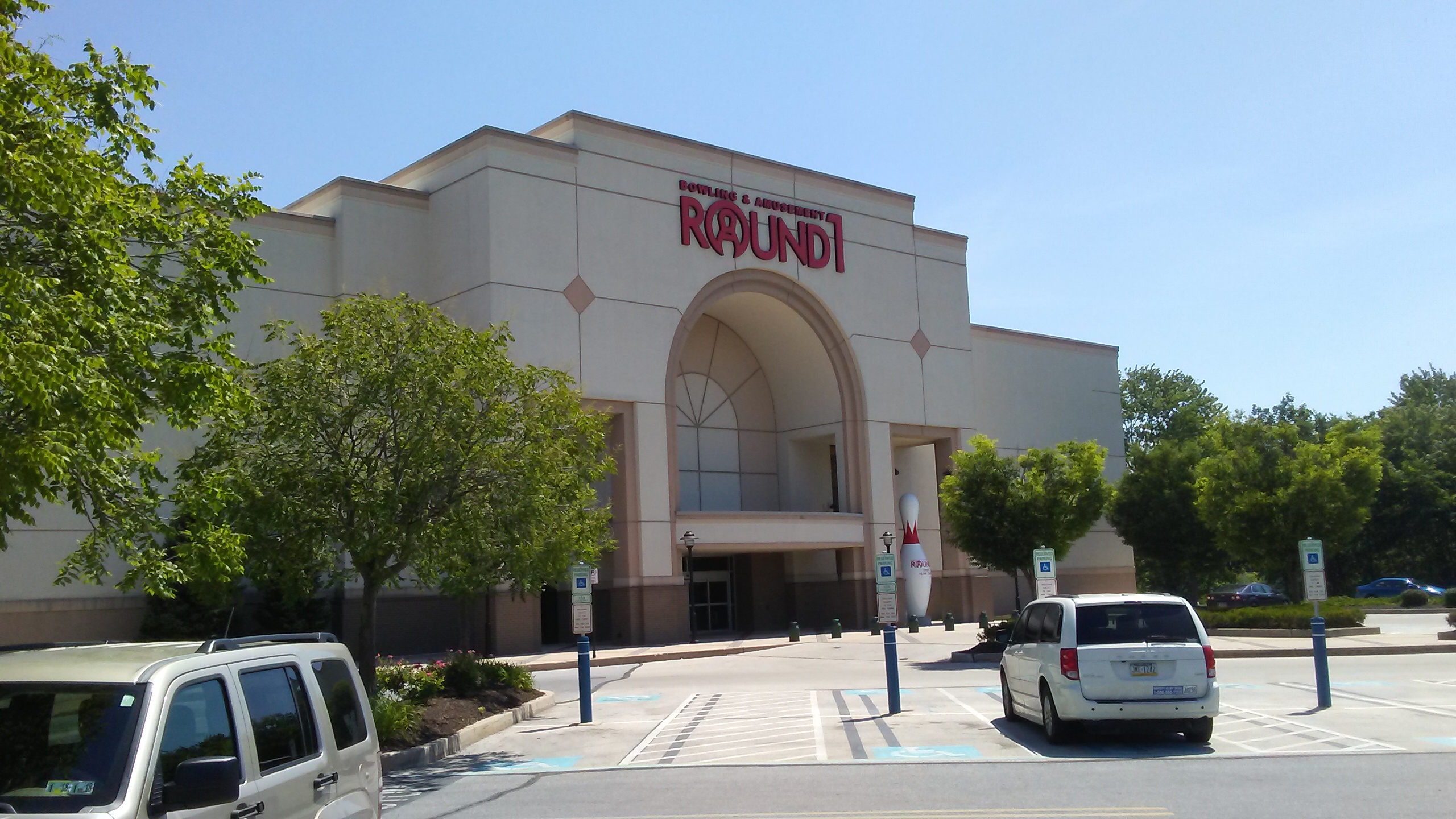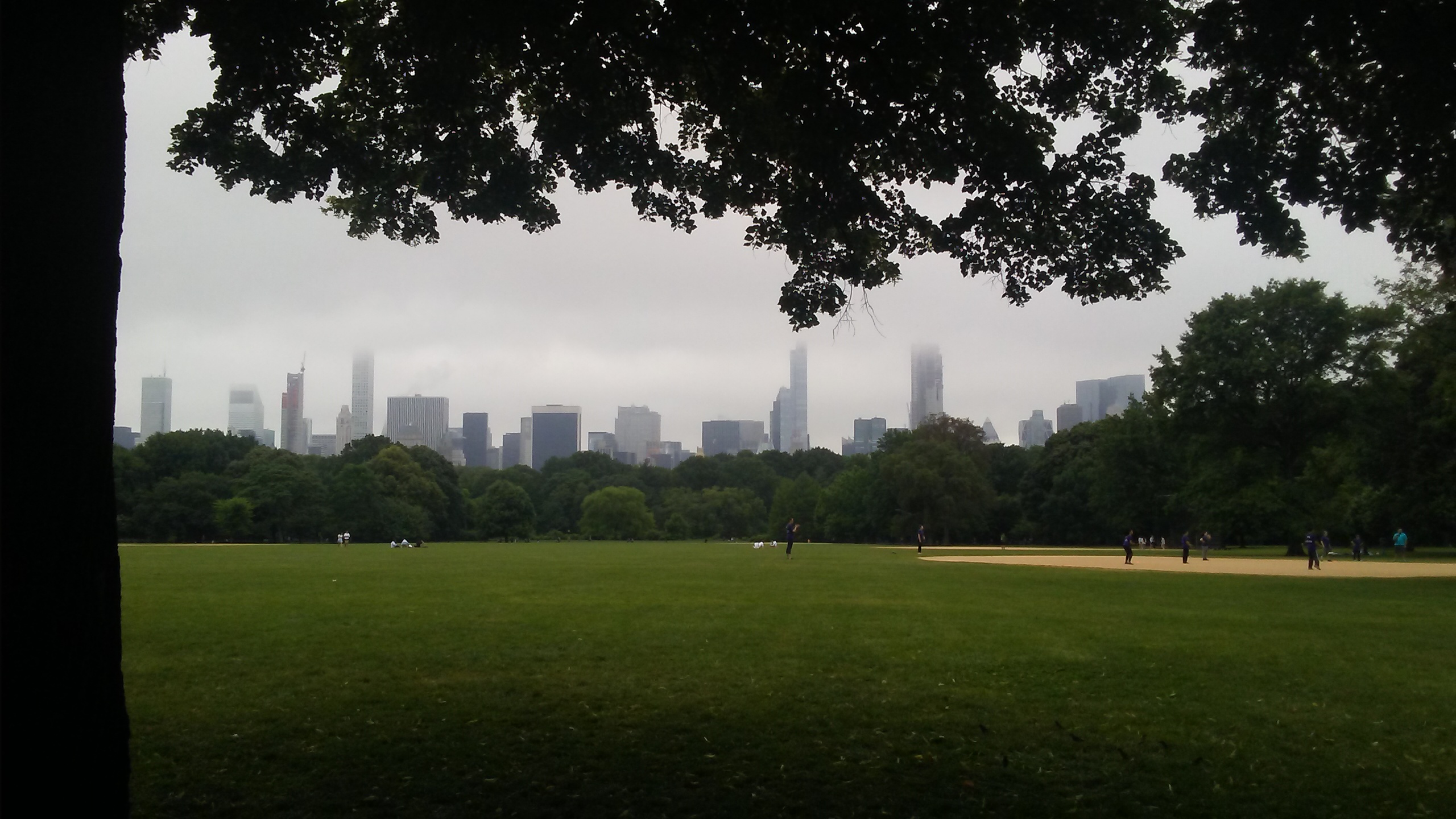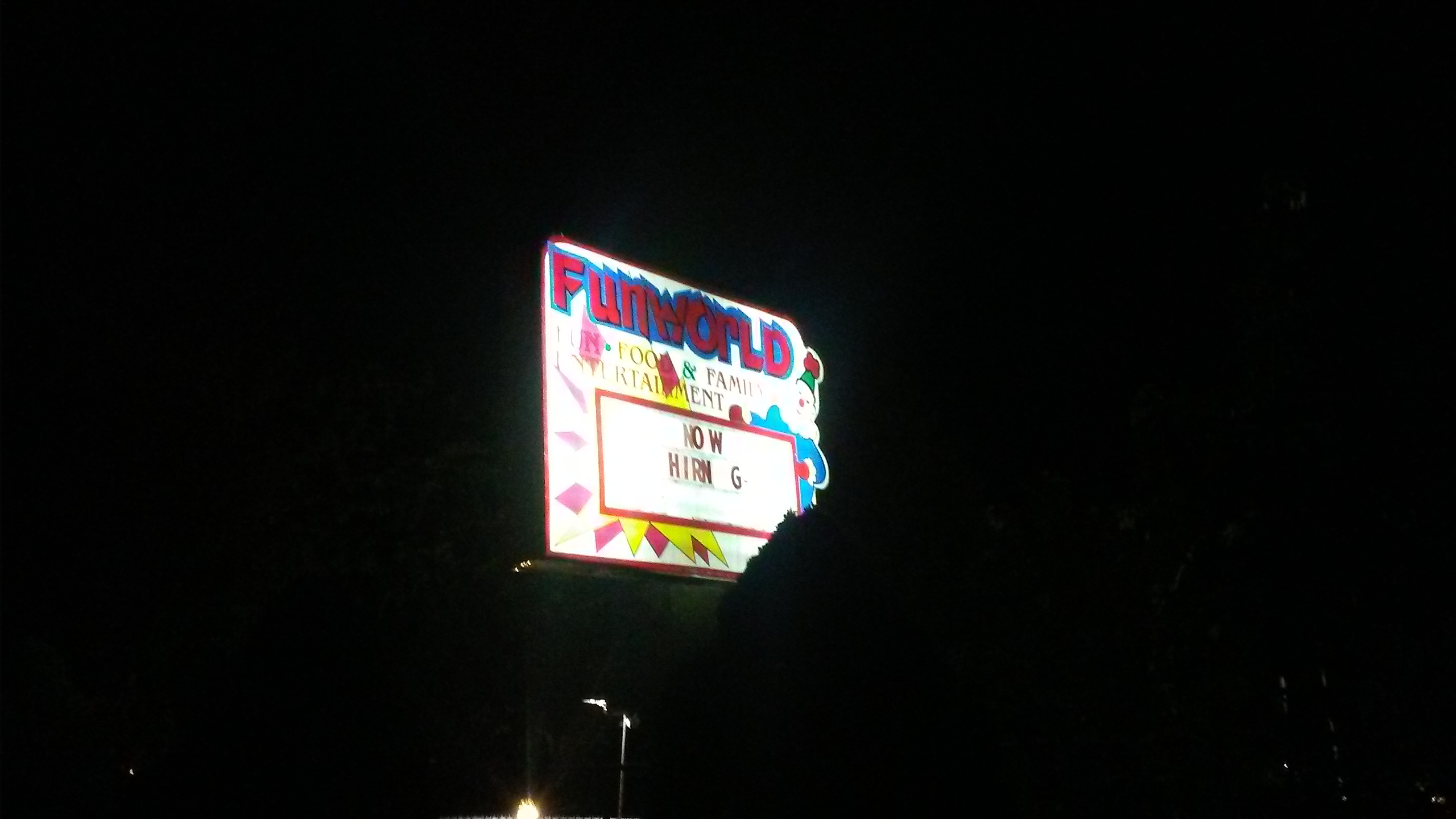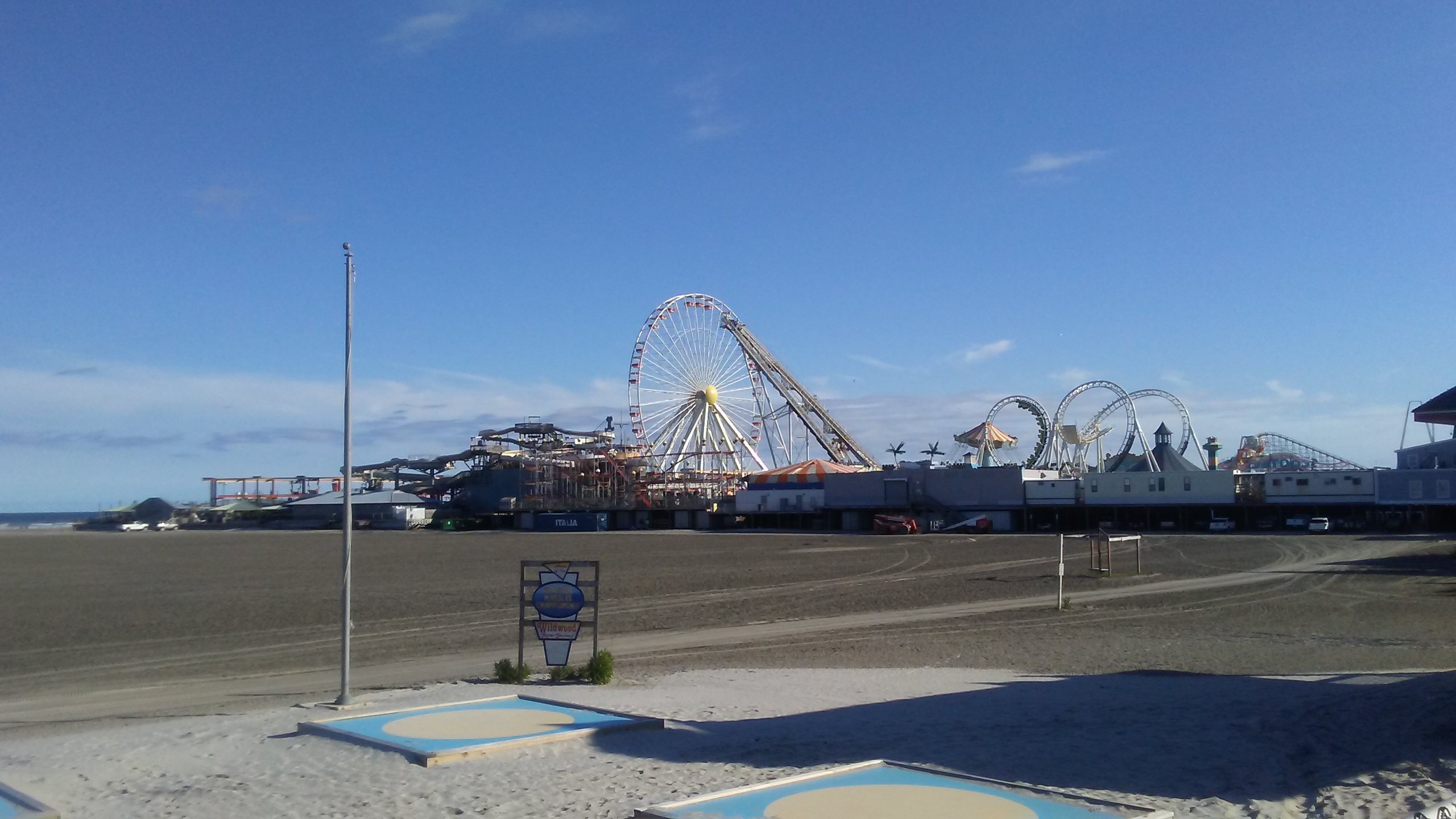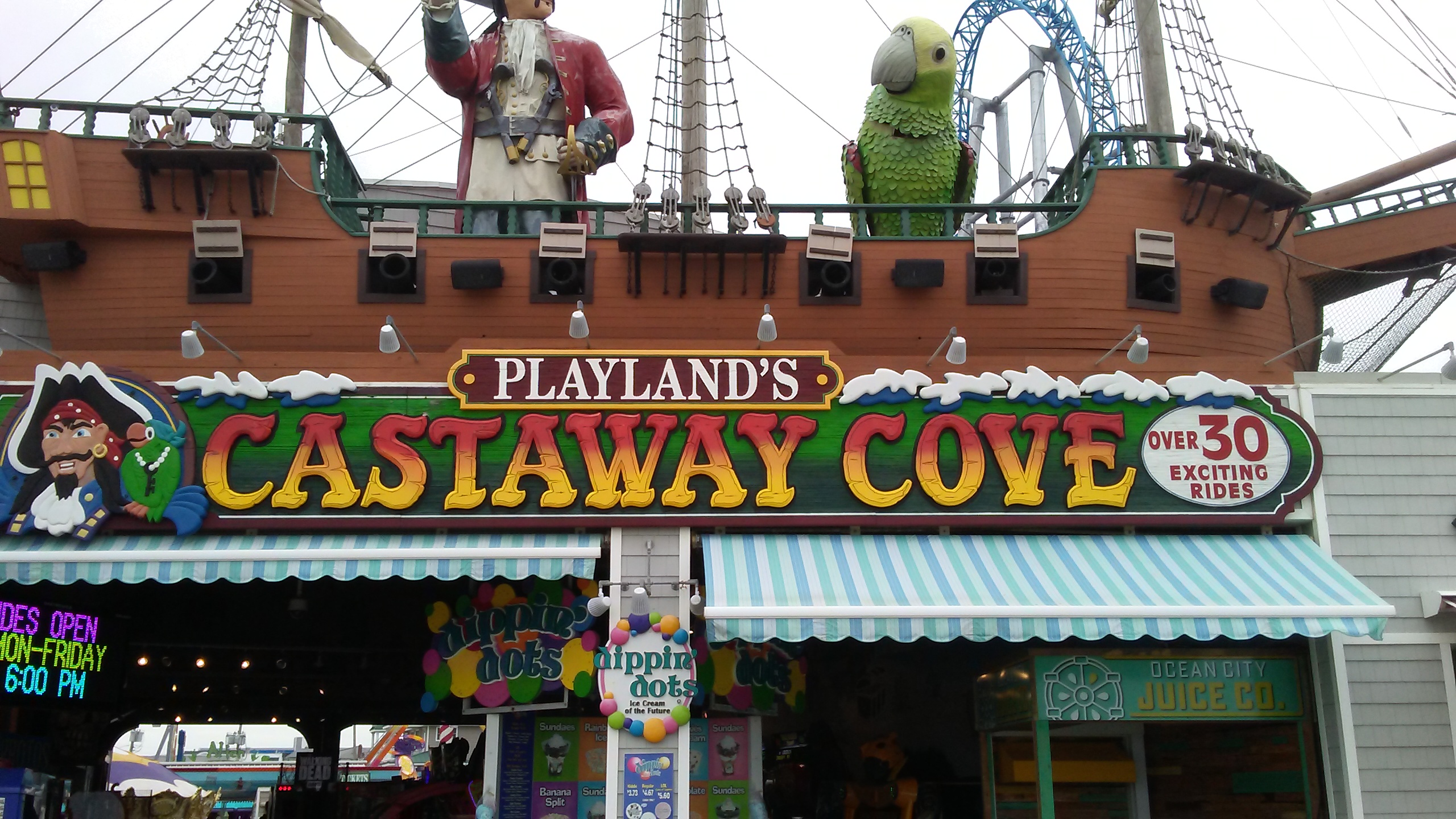
After a long journey, the first day is almost over. At the time the above picture was taken, the gentle mist had turned into full-blown rain. Thankfully, this sign says I’m in the right place.
Before anything else, let’s take a look at this sign. “Arcade” is listed here twice, once as “Arcade Family Fun Center” and once as “Arcade Guitar Hero 2”. I can assure you of two things: There’s only one arcade in this plaza and there’s no arcade port for Guitar Hero 2. The other side of the sign swapped “Guitar Hero 2” for “Deal or No Deal”, which actually is an arcade game. An arcade game that they don’t have here.

Thankfully, it wasn’t hard to find.

Electric Quarters is the name of this arcade, although you’d never know it from any of the signs. I think that tiny text under the open sign is the only place in the entire building that says it. This arcade is tucked away in the back of the plaza, so that big red “ARCADE” sign is outside for good reason. I think Toy Taxi is supposed to lure people deep down the passage to see the arcade.

One side of the arcade is facing a seldom-traveled side street. These banners aren’t here to show people where the business is, since you’d never know what kind of business it was from your car, but to let everyone know that they’re open. You see, Electric Quarters is only open for the three-month-long tourist season, like nearly every other arcade in Ocean City. This one is so far from the beach that I can’t imagine that many tourists wander out this far, but they still somehow manage to stay afloat.

Before we go in, I should also bring up that this place is marked as a historical landmark on the Facebook page. I’m not sure how old it is exactly, but research tells me that it’s been around since at least the late 80s. I know it doesn’t seem particularly old compared to all of the other ancient arcades in town, but this is the only one that shows its age. Even the Pepsi machine sitting out front looks like it’s been sitting there since they opened.
Curiously, this vending machine sells Coke and Mountain Dew, but no Pepsi.
Arcades visited: 7

It wasn’t easy to get a good establishing shot of this location. Electric Quarters has a lot of machines in a very small space, so they all block each other from view. This arcade is so cramped that there are several aisles that you simply can’t get through if anyone else is using them. This is what happens when you try to hold on to as many old machines as possible, even when you don’t have space for them. On the bright side, I don’t think they’re ever busy enough for it to be an issue.
I also really need to call attention to the big, white box near the top of the photo. That’s a TV/VCR combo available as a redemption prize. It says more about this arcade than I ever could.

This is as good a place to start as any. If you take a left immediately upon entering, you’ll be greeted with this very, very cramped hall of those upright games everyone thinks of when they hear “arcade game”. I wanted to get a better angle, but I literally couldn’t step back any further. This hall has a width of about three feet.

Here’s Police Trainer 2, a collection of about 20 quick-light gun-based minigames. It’s exactly what you’d expect from the title. There’s another series called Point Blank that does this same concept a lot better.

Galaga and Ms. Pac-man as you’ve never seen them before: In separate cabinets!

Since Raw Thrills is made up mostly of old Midway Games staff, a lot of their games are sorta-kinda sequels to older Midway games. That Terminator Salvation game you see at every arcade is the “sequel” to this. I’m not sure if Raw Thrills intentionally sought out the license for the sake of making a sequel to this game or if they simply ended up with the license and drew inspiration from the last Terminator game they worked on. Either way, it makes that game feel slightly less like shovelware, doesn’t it?

This is the first arcade machine in all of Ocean City that legitimately caught me off-guard. This here is Lethal Enforcers II: GunFighters. Back in the 90s, arcade games were just getting to the point where they could handle digitized sprites, so they abused the ever-loving hell out of it. For those who don’t know, digitized sprites are made by taking a 2D image of a 3D object and reducing it in quality enough to use as a sprite. The result is much more realistic graphics, at the cost of looking kind of awkward. Mortal Kombat is probably the best-known example.
The Lethal Enforcers games made heavy use of this technique. Every character in the game is a photo of an actor in a silly costume with 3 frames of animation and unenthusiastic voice acting. It’s pretty easy to see why most arcades have long since gotten rid of this game. Lethal Enforcers 2 features a wild west setting, so you can enjoy cowboy shootout music while you laugh at the terrible acting. I’m not sure if it’s ever come up before, but I’m a huge sucker for western music in video games.

The return of Tekken 3. It sticks out less here than the last place we saw it, but I still wouldn’t have expected to run into it twice on the same day. Only in Ocean City.
I know I repeat myself a lot, but I’m not well-versed in fighting games. Tekken has such a long and storied history behind it that I’d have enough material to fill paragraphs whenever I ran into it. I’m always disappointed whenever I have to give a non-commentary about a series like this.

Remember how I said American Eighteen Wheeler had three different cabinet types? This one is what’s known as the Naomi Upright Cabinet. Believe it or not, this was a strange attempt to localize one of those generic white Japanese cabs you see at every Japanese arcade, specifically the Naomi Universal Cab. The Japanese version of this hardware had a feature where you could slide the controls and monitor down to convert it into a sit-down cabinet. The American release of the machine stripped away this feature for obvious reasons.
Many Sega games from this era were released in a variation of this cab, including Crazy Taxi, Jambo Safari, most Virtua games, and Club Kart Prize (why does this series keep coming up?). Even a few that didn’t run on the Naomi hardware had this style of machine as an option, like OutRun 2. It’s not the only time Japanese-style machines have been brought over to America, but it certainly was one of the most widespread.
The other game in the photo is Harley Davidson & LA Riders, a Sega motorcycle game from 1997. Not only is it interesting to see a motorcycle game survive for 20 years, but Harley Davidson & LA Riders is a pretty significant game in Sega’s history. It was the first game to run on the Model 3 step 2 hardware, aka “the hardware upgrade that put the model 3 firmly above the Sega Dreamcast in terms of power”.

Well, here is the pinball. Don’t get excited, that’s not THE Strikes and Spares Pinball, just a machine from the late 80s with the same name.
Nobody reading this knows what I’m talking about, so let’s move on.

No matter how many arcades I visit, I always run into games I’ve never seen before. Ghost Catcher doesn’t seem to be rare, but I can’t find a thing about Fever Chance online. It reminds me of a scratch-off ticket vending machine for some reason.

There’s absolutely nothing I can say about that sign to make it any better.

Speaking of signs, this game has a strategy guide taped to the front. I’ve mentioned this before, but Colorama is one of the easiest common arcade games to cheese for tickets. Once you learn the timing, you can get it to land in the 75-ticket yellow space about half of the time. This paper taped to the front is just teaching people how to waste their money. If you’re putting in 5 tokens and only winning 25-40 tickets per spin, then that’s only 5-8 tickets per coin. Even the hardest-to-hit color, white, only gives you 25 tickets per coin. You can easily make more than that just by gaming yellow. Trust me, that’s how I used to farm tickets at my small arcade back home.

These were sitting back to back with the first four games I showed. I wonder if it’s profitable to have two Mortal Kombat machines sitting next to each other like that. Most people who come here to play Mortal Kombat probably don’t care which version they’re playing and aren’t going to bother to try both. Maybe this is a leftover relic from when Mortal Kombat was relevant.
I guess now is a good time to talk a bit about Target: Terror, too. As I mentioned earlier, it was Raw Thrills’ very first release. Just like most other Raw Thrills games, it was a trademark-dodging sequel to an older Midway game. In this case, it was Maximum Force.
Maximum Force, for anyone who didn’t play it when it was in every Godfather’s Pizza, was one of those shooting games with cheesy actors akin to Lethal Enforcers. Digitized sprites sure as hell weren’t going to fly in 2004, but Raw Thrills decided that if nobody was going to take a game like this seriously, then neither would they. The result is a straight-faced parody of 90s light gun shooters, with silliness such as random ninjas mixed in with the plainclothes terrorists. To make the sprites as authentically crappy as possible, every “actor” in the game was played by a member of the development team giving the hammiest performance they could muster. Even though I have my issues with Raw Thrills, I have to give credit where credit is due for having the balls to release something like this as their very first video game.

Oh, interesting. It’s an arcade version of that midway game (not “Midway Games”) where you roll the balls into the holes to make the horses run. A series of holes at the end of the path make your horse run. The harder-to-hit holes make your horse run faster. It’s pretty faithful to the midway version, all the way down to the triangular hold setup. The full-sized game was one of my favorite carnival-esque attractions at Circus Circus when I was young, so I’m about 90% sure I took a picture of it when I was out there. It should be on this blog somewhere…

These 12 tickets were able to buy 3 pieces of Starburst.

I just took this photo for the racing game article. I usually ignore this series unless I have a good reason to comment on it. Only looking at it now do I admire what a huge difference the plastic bits around the screen make. The cab isn’t all that different than the first Fast and Furious game, but it looks a lot more modern, doesn’t it?
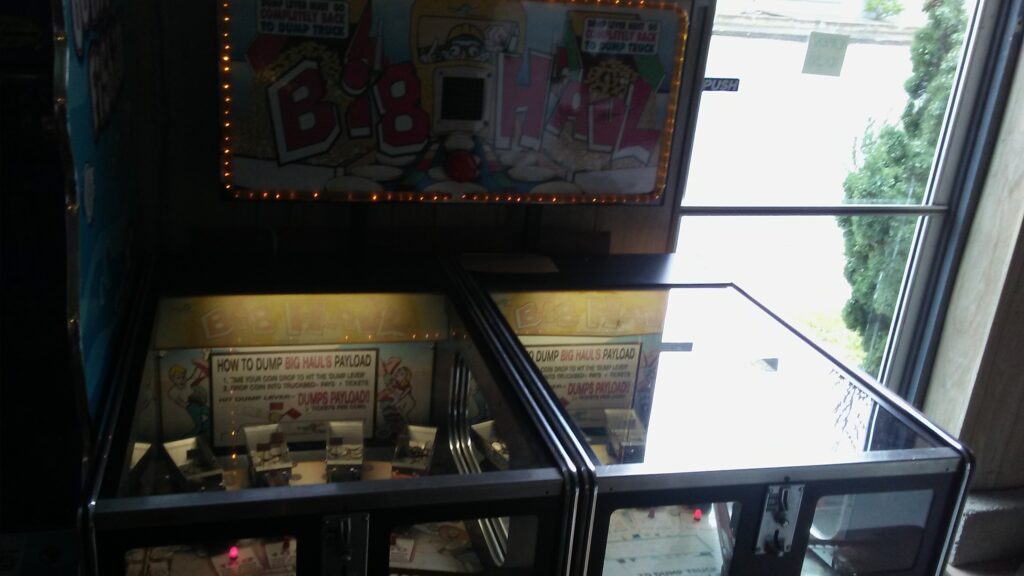
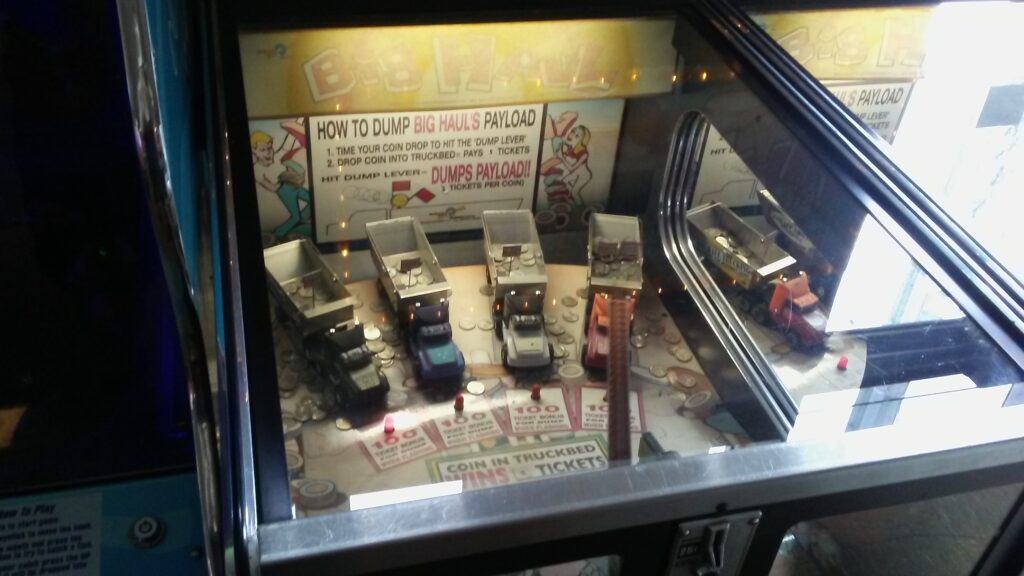
I’ve almost certainly posted a picture of this one before at some point in the past, but I don’t think I’ve ever talked about it. This is Big Haul Truckin’, another one from the late 90s era of coin-rolling games. This was one of the most popular ones for some reason. Instead of a static path and moving targets, the targets are all stationary while the path swings back and forth. Landing your coin in a truck gets you a few coins, but that’s not what you’re aiming for. Each truck has a sign sticking out. Striking the sign with a token hard enough makes the truck dump all of its coins into the back, giving you a huge number of tickets for each coin built up. The target was so finicky that I suspect it was rigged to only payoff after a certain number of players.
I only bring up this machine because it used to be so popular. This was almost always the game people would dump money into if they were trying to win tickets. Of course, like all token-rolling games, the switch to swipe cards has made it a lot rarer than it used to be.

Next up is another antique Pokerino machine. This ones for sale, if you have 2000 dollars sitting around. It must not get much play, since they’re using two of them as stuffed animal shelves. Again, this arcade was very, very low on space.

Those weren’t the only antique machines in Electric Quarters. Do you remember that arm-pushing machine I ranted about back in the prologue? This is a very primitive version of that. When you put in a coin, the mechanical arm moves and potentially shoves the various prizes into the center whole. These two happen to be stocked with tickets and zippo lighters. Only in Ocean City can you find antique arcade machines being used as extra shelf space.

These two games are Pop-a-Ball and Hop-a-Tic-Tac-Toe. Both games work the same way, but the objectives differ slightly. Each of the 25 holes in the Pop corresponds to a poker card. When you start the game, the balls will be popped into the air and roll around until they land in whichever 5 holes they fill. This determines your Poker hand. Like in real video poker, you can hold onto any number of cards and pop the remaining balls again, rerolling them. In essence, it’s just video poker with a gimmicky way of determining your hand. Hop is the same, exact game, but the game is tic tac toe instead of poker.
We had both of these next to each other in my hometown arcade. I didn’t realize until just now how old they were. Pop is from 1988 and Hop is from 1991. That would explain why I’ve never seen them anywhere else. I’d forgotten about them completely until coming to this arcade. I’m always happy to run into anything that reminds me of my home arcade since it finally closed down back in 2015.

Here’s a pretty unique coin pusher. Instead of rolling the coin down from the top, you put it in at the bottom of the front and throw the coin at the goal area. I’m pointing out this particular coin pusher because it has little soccer balls sitting on top of the coins that give a bonus if you can push them off the side. I’m certain that’s something the arcade came up with and not a standard feature of the game. I can’t imagine it’s even possible to push the ball off, since you need to push the coins up an incline before they’re shoved off. Won’t the ball just roll down the tops of the coins?

Now we get to the back hall of games. This is where they tucked away the bigger games. Look at all of these Basketball machine variations from the late 80s and early 90s. I particularly like the one shaped like a giant high-top sneaker. I vaguely recall seeing it somewhere, but the location escapes me. “Circus Circus” is always the first thing that comes to mind when I think of games like this.

Speaking of Circus Circus, if you ask me which game comes to mind when I think of that game room, this would probably be my answer. Back in the very early 90s, something about this machine’s look stuck in my mind. Every year when we went to Circus Circus, it was always there. I was far too young to play it effectively, but it was there. For some reason, this was the machine that embodied the ideal of that arcade in my mind. To this day, I’m still not entirely sure why this machine drew my attention as it did.
And yeah, it’s supposed to have a head.

Penny horse!
Back in Michigan, where I grew up, there’s a rather large chain of department stores called Meijer. Think of them like a smaller, crappier K-mart that’s less corporate. One of the chain’s trademarks is that every store has Sally the penny horse sitting in the area just beyond the checkout lanes. At one point the store’s commercials even proudly declared that “pony rides are still just a penny”. I remember they even had a scale replica of her built out of legos in the store with a contest to guess how many went into making it. Meijer is damn proud of their penny horse.

I guess now is a good time to mention that every arcade in Ocean City still runs on quarters instead of swipe cards. Even token arcades are pretty rare. I was looking forward to having lots of new swipe cards to add to my ever-growing pile, but it wasn’t meant to be. On the bright side, coin-rolling games are still viable out here.

This is a ghost-shooting game for children. The screen was so low that it took me a while to realize why my gun wasn’t registering. I had to get down on my knees to get a straight shot at the screen. Something about this game struck me as slightly off, so I decided to look up who made it out of curiosity. It turned out to be LAI. Again. At least I can say I’ve heard of them this time.

This game looks really interesting, doesn’t it? Well, it’s not. The animatronic chickens move their heads around slightly but have absolutely nothing to do with the game. All you do in this one is pushing the yellow buttons when they light up. The chickens don’t even move in reaction to their button being pressed. Why did they put so much effort into making those chickens just for something like this?
Every 30 seconds or so, this machine also yells “Clucky, Plucky, Lucky, Ducky, and Crispy” with the thickest, most stereotypically dumb-sounding southern accent possible. It got old quickly.

UPDATE: While the Electric Quarters arcade still exists, they renovated the venue into an ice cream shop. There’s still an arcade, but it’s much smaller and consists almost entirely of brand-new games. Electric Quarters, as I wrote about here, is essentially gone.
That was the last machine of interest. At this point, the rain was starting to come down hard. That miniature golf place next door looks interesting, but this post is already over 3000 words. We’re going to have to stretch it out into a part 4. Hopefully, it’ll be a short one.

